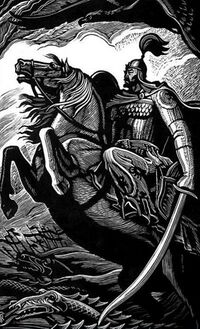Burania: Difference between revisions
mNo edit summary |
m (→History) |
||
| Line 37: | Line 37: | ||
==History== | ==History== | ||
[[File:Alyp Manas.jpg|200px|thumb|right|Alyp Manas leading the Buranic horde in c. 1250]] | [[File:Alyp Manas.jpg|200px|thumb|right|Alyp Manas leading the Buranic horde in c. 1250]] | ||
In Aroman discourse, the words Buran and Buranic could designate a certain mentality. Buranic people were typically depicted as being very strong, with a violent temper to match. Their nomadic lifestyle was contrasted to the urbanized agricultural civilisation of Aroma. Historically, two related yet divergent cultures are distinguished: the interior and coastal Buranic peoples. | In Aroman discourse, the words Buran and Buranic could designate a certain mentality. Buranic people were typically depicted as being very strong, with a violent temper to match. Their {{wp|nomadic lifestyle}} was contrasted to the urbanized agricultural civilisation of [[Aroman Empire|Aroma]]. Historically, two related yet divergent cultures are distinguished: the interior and coastal Buranic peoples. | ||
The Buranic interior has long been home to nomadic steppe cultures living on the East-Europan plain. They domesticated the horse around 3200 BCE, leading to a more mobile lifestyle. These steppe tribes often appear in history as invaders of the Occident and Orient. | The Buranic interior has long been home to nomadic steppe cultures living on the East-Europan plain. They domesticated the {{wp|horse}} around 3200 BCE, leading to a more mobile lifestyle. These steppe tribes often appear in history as invaders of the [[Occident]] and [[Orient]]. | ||
Along the Buranic coasts there lived seafaring cultures. These Buranic pirates and mercenaries attacked ships along the Occidental coast. Zenith of pirates' power was under the | Along the Buranic coasts there lived seafaring cultures. These Buranic pirates and mercenaries attacked ships along the Occidental coast. Zenith of the pirates' power was under the [[Volsci]]an [[Volsci#Politics|triumvirate]]. Most of their attacks were focused on trade lines and unprotected convoys, relying on ambush and surprise. The Buranic pirates attacked in large numbers, trying to steal enemy ships using underhanded tactics. Or they disguised themselves as a ship in distress, waiting for their prey to approach. | ||
* WIP: (Pseudo-Anglo-Germano-Russo-Fennoscandian cultures) | * WIP: (Pseudo-Anglo-Germano-Russo-Fennoscandian cultures) | ||
Revision as of 20:26, 17 January 2020
 | |
| Demonym | Buranic |
|---|---|
| Languages | List of languages |
| Largest cities | |
The region of Burania is a subcontinent in northeast Europa with colder climates.
Etymology
The name Burania derives from Bureas or Boreas (Βορέας, also Βορρᾶς), the Aroman god of the cold north wind and the bringer of winter.
Geography
Burania is home to several nations.
History
In Aroman discourse, the words Buran and Buranic could designate a certain mentality. Buranic people were typically depicted as being very strong, with a violent temper to match. Their nomadic lifestyle was contrasted to the urbanized agricultural civilisation of Aroma. Historically, two related yet divergent cultures are distinguished: the interior and coastal Buranic peoples.
The Buranic interior has long been home to nomadic steppe cultures living on the East-Europan plain. They domesticated the horse around 3200 BCE, leading to a more mobile lifestyle. These steppe tribes often appear in history as invaders of the Occident and Orient.
Along the Buranic coasts there lived seafaring cultures. These Buranic pirates and mercenaries attacked ships along the Occidental coast. Zenith of the pirates' power was under the Volscian triumvirate. Most of their attacks were focused on trade lines and unprotected convoys, relying on ambush and surprise. The Buranic pirates attacked in large numbers, trying to steal enemy ships using underhanded tactics. Or they disguised themselves as a ship in distress, waiting for their prey to approach.
- WIP: (Pseudo-Anglo-Germano-Russo-Fennoscandian cultures)
Culture
The Curse of Buran is a belief that Buranic people have been under the influence of a malicious spell for many centuries. The "curse" manifests itself as pessimism, inner strife, and several historic misfortunes. The curse is also blamed for causing many personal troubles. Examples of this curse include:
- Defeat against the Aromans at the Battle of Cryophobae in 279 CE
- Loss of Vanarambaion to the Aroman successor states in 699
- Buranic Spring of 2018 was crushed by Volscian military, leading to severe reprisals and mass exodus of many Europans.
See also
References
This template may be deleted.
